Ulysses S. Grant
Ulysses S. Grant Biography
Overview
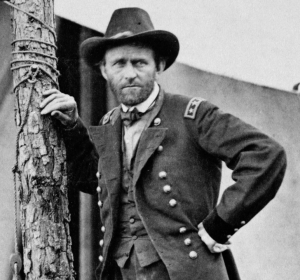
Picture File Source (2)
Ulysses S. Grant (born Hiram Ulysses Grant; April 27, 1822 – July 23, 1885) was an American military leader who served as the 18th president of the United States from 1869 to 1877. As president, Grant was an effective civil rights executive who created the Justice Department and worked with the Radical Republicans to protect African Americans during Reconstruction. As Commanding General, he led the Union Army to victory in the American Civil War in 1865 and thereafter briefly served as Secretary of War.[1]
Julia Grant
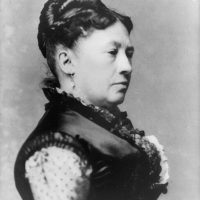
Quick Facts:
| Full Name | Ulysses S. Grant |
| Birth Date | April 27, 1822 |
| Birth Place | Point Pleasant, Ohio |
| Death Date | July 23, 1885 |
| Career | Soldier |
| Spouse(s) | August 22, 1848, to Julia Boggs Dent (1826–1902) |
| Children | Frederick Dent (1850–1912) Ulysses Simpson (1852–1929) Ellen Wrenshall (1855–1922) Jesse Root (1858–1934) |
| President No. | 18 |
| Presidency Begin | April 15, 1869 |
| Presidency End | March 4, 1877 |
| Vice President(s) | Schuyler Colfax (1869–1873) Henry Wilson (1873–1875) |
| Administation | Millercenter.org |
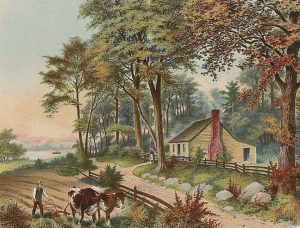
Born Hiram Ulysses Grant, in Point Pleasant, Ohio, the future General-in-Chief’s name was changed due to a clerical error during his first days at the United States Military Academy at West Point.
Grant was born in Point Pleasant, Ohio, on April 27, 1822, to Jesse Root Grant, a tanner and merchant, and Hannah Simpson Grant.
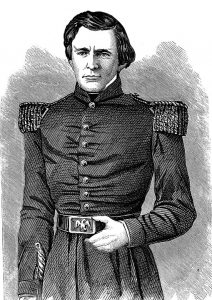
In 1839 Grant’s father Jesse got Ulysses an appointment to the United States Military Academy at West Point, New York. Grant did not have any interest in the military but he did not have any other options that would allow him to get an education.
Representative Thomas L. Hamer nominated Grant to West Point but submitted an incorrect name, Ulysses S. Grant, thus West Point registered him with that name.
Grant was a mediocre student graduating 21st out of 39 students. He did excel at horsemanship and math and took interest in art and reading classic books. [12]
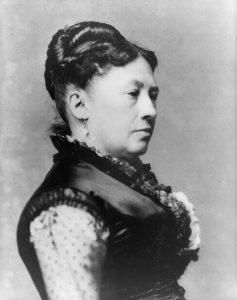
After graduating from West Point, Grant was assigned as a brevet second lieutenant to the 4th U.S. Infantry, stationed near St. Louis, Missouri, where he met and fell in love with Julia Boggs Dent, the sister of his West Point roommate Frederick Tracy Dent. They became secretly engaged before Grant left to serve in the Mexican-American War (1846–48) and married when he returned.
Julia was born with strabismus (more commonly known as “crossed eyes”) which prevents both eyes from lining up in the same direction, Because her strabismus was never corrected, Julia almost always posed in profile for portraits.[19]
In July 1848, after they had been apart for four years, Grant’s regiment returned to the United States, and he took leave so that he could make wedding arrangements in St. Louis. Grant’s father, Jesse Grant, refused to attend their wedding (August 22, 1848), objecting not to Julia, but to her family’s owning slaves.
After the Grants were married, Ulysses returned to the Army. Julia gave birth to Frederick Dent Grant in 1850 and Ulysses Simpson Grant in 1852 while her husband was dispatched to the West Coast for several years. Unhappy to be so far from his family, Ulysses resigned from the Army in 1854 and the Grants moved to a small farm called “Hardscrabble” in St. Louis.[20]
The Grants had three sons and a daughter:[21]
Frederick Dent Grant (1850–1912)—soldier, public official.
Ulysses Simpson Grant, Jr. known as “Buck” (1852–1929)—lawyer.
Ellen Wrenshall Grant known as “Nellie” (1855–1922)—homemaker.
Jesse Root Grant (1858–1934)—engineer.
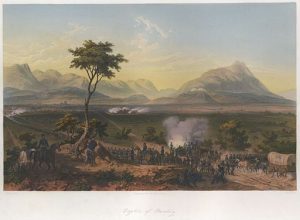
On May 8, 1846, three days before the US declared war on Mexico, Grant participated in the Battle of Palo Alto. Lieutenant Grant had his first taste of war. The following day Grant took part in the Battle of Resaca de la Palma, which resulted in the Mexican army’s retreat across the river. In September, at the Battle of Monterey, Grant distinguished himself by galloping through the streets of the city while under fire from Mexican troops, to deliver a request for ammunition.
In 1847, after President Polk sent Gen. Winfield Scott to invade central Mexico, Grant’s regiment was transferred to Gen. William Worth’s division. Following the landing of U.S. troops at Vera Cruz in March and the city’s subsequent capitulation, Grant took part in the Battle of Cerro Gordo, where future adversary Robert E. Lee experienced his first taste of combat. Grant was afterward present at all major battles that preceded the fall of Mexico City. During the occupation Grant’s regiment was stationed at Tacubaya, a suburb of the capital.

When the Civil War began in April 1861, Grant was working as a clerk in his father’s leather goods store in Galena, Illinois. When the war began his early efforts to be recommissioned were rejected by Major General George B. McClellan and Brigadier General Nathaniel Lyon. But on April 29, with the help of Congressman Elihu B. Washburne became his patron in political affairs and promotions in Illinois and nationwide. [70]
Grant was appointed military aide to Governor Richard Yates and mustered ten regiments into the Illinois militia. On June 14, again aided by Washburne, Grant was promoted to Colonel and put in charge of the unruly 21st Illinois Volunteer Infantry Regiment, which he soon restored to good order and discipline.[71]
Maj. Gen. John C. Frémont, who viewed in Grant an “iron will” to win, appointed Grant to commander of the District of Cairo. Grant became famous around the nation after capturing Fort Donelson in February 1862 and was promoted to Major General by President Abraham Lincoln.
After capturing Fort Henry on the Tennessee River on February 6, 1862, Brig. Gen. Ulysses S. Grant advanced 12 miles cross-country to invest Fort Donelson on the Cumberland River. By February 13, Grant had surrounded the fort with about 25,000 men and had conducted several small attacks to probe the fort’s defenses. On February 16, Confederate commander Brig. Gen. John B. Floyd and some other senior commanders escaped the fort, turning over command to Gen. Simon Bolivar Buckner, a pre-war friend of Grant. Later that day, Buckner reluctantly surrendered the remaining garrison unconditionally to his old friend Grant. The capture of Forts Henry and Donelson were major victories for Grant. They opened Tennessee for Union advances up the Tennessee and Cumberland Rivers. Grant received a promotion to major general for his victory and attained stature in the Western Theater earning Grant the name “Unconditional Surrender.”[72]
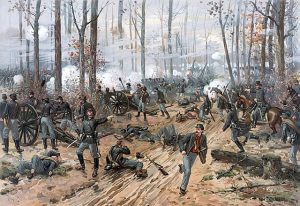
The next major battle for Grant was the Battle of Shiloh (see also Wikipedia’s incredible page) on April 6 and 7 of 1862. Shiloh church was located in southwestern Tennessee near Pittsburg Landing on the west bank of the Tennessee River. General Albert Sidney Johnston, commander of the Confederate Army of Mississippi launched a surprise attack on Grant’s army from its base in Corinth, Mississippi. Grant was caught by surprise and was under manned and outfought. Grant was expecting reinforcement from Don Carlos Buell’s Army of the Ohio. Buell’s army did not arrive until the evening. Grant’s men suffered tremendous losses and the Union army fell back to re-group and wait for help. Buell’s army arrived in the evening and Grant attacked early the next morning along the entire line and Confederate forces were forced to retreat, ending their hopes of blocking the Union advance into northern Mississippi.
Grant and the Union army was victorious but at a huge cost, it was the bloodiest engagement of the Civil War up to that point, with nearly twice as many casualties as the previous major battles of the war combined. Union casualties 13,047; 1,754 killed, 8,408 wounded, 2,885 missing & captured.(source: battlefields.org)
Grant’s reputation was also hurt in the battle because of the huge losses and the army being surprised. The White House was overwhelmed with demands for Grant’s removal but Lincoln replied “I can’t spare this man; he fights.” However, after Shiloh, Senior Union Commander Henry Halleck combined and reorganized his armies, relegating Grant to the powerless position of second-in-command.
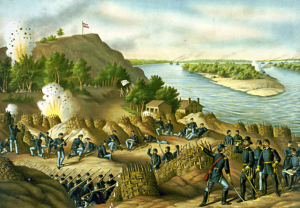
The Vicksburg campaign directed against Vicksburg, Mississippi, a fortress city that dominated the last Confederate-controlled section of the Mississippi River. The Union Army of the Tennessee under Maj. Gen. Ulysses S. Grant gained control of the river by capturing this stronghold and defeating Lt. Gen. John C. Pemberton’s forces stationed there. [81]
The campaign consisted of many important naval operations, troop maneuvers, failed initiatives, and eleven distinct battles from December 26, 1862, to July 4, 1863. The campaign demonstrated Grant’s determination and his “never quit” attitude. He took a lot of risks and most of them failed but his army kept fighting and eventually surrounded Vicksburg. The Union forces could not breach the Confederate’s defenses. So Grant cut off all supplies and reinforcements and put the City under a constant barrage of artillery. Finally on July 4, after six weeks in which the soldiers and civilians of Vicksburg had no food supplies and were bombarded constantly, Pemberton surrendered the city and his army. For much more details on the Vicksburg please see Wikipedia, Battlefields.org, NPS.org, Wikipedia-Siege of Vicksburg and Historynet.
Vicksburg’s fall gave Union forces control of the Mississippi River and split the Confederacy. [82] The success at Vicksburg was a morale boost for the Union war effort.[83] When Stanton suggested Grant be brought back east to run the Army of the Potomac, Grant demurred, writing that he knew the geography and resources of the West better and he did not want to upset the chain of command in the East.[84]
The Battle of Chattanooga consisted of three separate battles that occurred over the course of three days in November 1863. The three battles were the Battle of Orchard Knob, The Battle of Lookout Mountain, and the Battle of Missionary Ridge.[85]
Lincoln promoted Grant to major general and assigned him command of the newly formed Division of the Mississippi on October 16, 1863, including command of the Armies of the Ohio, Tennessee, and Cumberland. After the Battle of Chickamauga, the Army of the Cumberland retreated into Chattanooga where they became trapped. Grant arrived in Chattanooga on horseback, assisted by Major General Joseph Hooker, with plans to resupply the city and break the siege. Union forces captured Brown’s Ferry and opened a supply line to Bridgeport.[86]
On November 23, Grant organized three armies to attack at Missionary Ridge and Lookout Mountain. Two days later, Hooker’s forces took Lookout Mountain. Grant ordered Major General George Henry Thomas to advance when Sherman’s army failed to take Missionary Ridge from the northeast. The Army of the Cumberland, led by Major General Philip Sheridan and Brigadier General Thomas J. Wood, charged uphill and captured the Confederate entrenchments at the top, forcing a retreat. The decisive battle gave the Union control of Tennessee and opened Georgia, the Confederate heartland, to Union invasion. [87]
On March 2, 1864, Lincoln promoted Grant to Lieutenant General, giving him command of all Union Armies. Grant’s new rank had only previously been held by George Washington. Grant arrived in Washington on March 8, and he was formally commissioned by Lincoln the next day at a Cabinet meeting. Grant developed a good working relationship with Lincoln, who allowed Grant to devise his own strategy.[88]
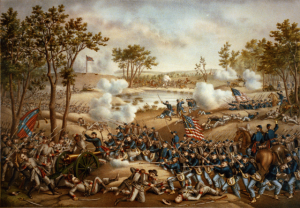
The Overland Campaign was a series of brutal battles fought in Virginia for seven weeks during May and June 1864. Grant immediately made plans to press the Confederates everywhere simultaneously. George Meade’s Army of the Potomac would march against Robert E. Lee’s Army of Northern Virginia, while William T. Sherman in Georgia, Nathaniel Banks in Louisiana, Benjamin Butler on the James River and Franz Sigel in the Shenandoah Valley would all advance on the enemy armies in their fronts. Grant recognized the Confederates could not win a war of attrition, and he instilled in his commanders the need to exhaust the resources of the Rebels by destroying their armies and their means to fight.[90]
Although Grant suffered severe losses during the campaign, it was a strategic Union victory. It inflicted proportionately higher losses on Lee’s army and maneuvered it into a siege at Richmond and Petersburg, Virginia, in just over eight weeks.[91]
The campaign was a series of many battles, please look at these websites for some great details: Wikipedia – Overland, Battlefields.org – Overland Campaign,
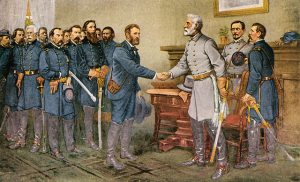
The Appomattox campaign was a series of battles fought March 29 – April 9, 1865, in Virginia that concluded with the surrender of Confederate General Robert E. Lee’s Army of Northern Virginia.
Grant’s troops surrounded Lee’s army at Petersburg. They cutoff all their supply lines and Lee’s troops were tired, hungry and being attacked continuously. Lee ordered the evacuation of Confederate forces from both Petersburg and Richmond on the night of April 2–3 before Grant’s army could cut off any escape. Confederate government leaders also fled west from Richmond that night.
Grant’s Union Army pursued Lee’s fleeing Confederates relentlessly. During the next week, the Union troops fought a series of battles with Confederate units, cut off or destroyed Confederate supplies and blocked their paths to the south and ultimately to the west. On April 6, 1865, the Confederate Army suffered a significant defeat at the Battle of Sailor’s Creek, Virginia, where they lost about 7,700 men killed and captured and an unknown number wounded. Nonetheless, Lee continued to move the remainder of his battered army to the west. Soon cornered, short of food and supplies and outnumbered, Lee surrendered the Army of Northern Virginia to Grant on April 9, 1865, at Appomattox Court House, Virginia.[100]
The campaign was a series of many battles, please look at these websites for some great details: Wikipedia – Appomattox, Battlefields.org – Appomattox Campaign, Appomattox Battlefield, Historynet – Appomattox
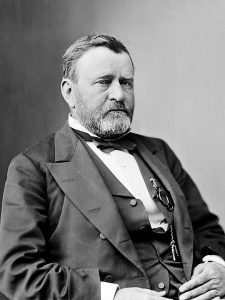
On March 4, 1869, Grant was sworn in as the eighteenth President of the United States. In his inaugural address, Grant urged the ratification of the Fifteenth Amendment, while large numbers of African Americans attended his inauguration. He also urged that bonds issued during the Civil War should be paid in gold and called for “proper treatment” of Native Americans and encouraged their “civilization and ultimate citizenship”.[110]
Grant was considered an effective civil rights president, concerned about the plight of African Americans. On March 18, 1869, Grant signed into law equal rights for blacks, to serve on juries and hold office, in Washington D.C., and in 1870 he signed into law the Naturalization Act that gave foreign blacks citizenship. During his first term, Reconstruction took precedence.
In 1870, to enforce Reconstruction, Congress and Grant created the Justice Department that allowed the Attorney General and the new Solicitor General to prosecute the Klan. Congress and Grant passed a series of enforcement laws, designed to protect blacks and Reconstruction governments.
During Grant’s second term, the North retreated from Reconstruction, while southern conservative whites called “Redeemers” formed armed groups, the Red Shirts and the White League, who openly used violence, intimidation, voter fraud, and racist appeals to overturn Republican rule. Northern apathy toward blacks, the depressed economy and Grant’s scandals made it politically difficult for the Grant administration to maintain support for Reconstruction.
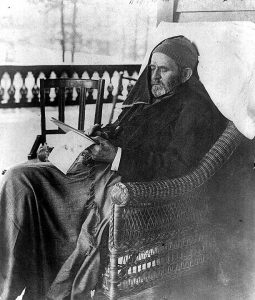
On May 16, 1877 Grant and Julia left for England aboard the SS Indiana. During the tour the Grants made stops in Europe, Africa, India, and points in the Middle East and Far East, meeting with notable dignitaries such as Queen Victoria, Pope Leo XIII, Otto von Bismarck, Emperor Meiji and others. Grant was the first U.S. president to visit Jerusalem and the Holy Land.
As a courtesy to Grant by the President Hayes his touring party received federal transportation on three U.S. Navy ships: a five-month tour of the Mediterranean on the USS Vandalia, travel from Hong Kong to China on the USS Ashuelot, and transportation from China to Japan on the USS Richmond. During the tour, the Hayes administration encouraged Grant to assume a public unofficial diplomatic role to represent the United States and strengthen American interests abroad, while resolving issues for some countries in the process.
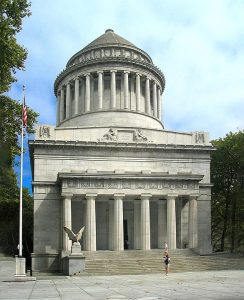
After a year-long struggle with throat cancer, surrounded by his family, Grant died at 8:08 a.m. in the Mount McGregor cottage on July 23, 1885, at the age of 63. Sheridan, then Commanding General of the Army, ordered a day-long tribute to Grant on all military posts, and President Grover Cleveland ordered a thirty-day nationwide period of mourning. After private services, the honor guard placed Grant’s body on a special funeral train, which traveled to West Point and New York City. A quarter of a million people viewed it in the two days before the funeral. Tens of thousands of men marched with Grant’s casket drawn by two dozen black stallions to Riverside Park in the Morningside Heights neighborhood of Upper Manhattan. His pallbearers included Union generals Sherman and Sheridan, Confederate generals Simon Bolivar Buckner and Joseph E. Johnston, Admiral David Dixon Porter, and Senator John A. Logan, the head of the GAR. Following the casket in the seven-mile-long procession were President Cleveland, the two living former presidents Hayes and Arthur, all of the President’s Cabinet, as well as the justices of the Supreme Court.
Attendance at the New York funeral topped 1.5 million. Ceremonies were held in other major cities around the country, while Grant was eulogized in the press and likened to George Washington and Abraham Lincoln. Grant’s body was laid to rest in Riverside Park, first in a temporary tomb, and then—twelve years later, on April 17, 1897—in the General Grant National Memorial, also known as “Grant’s Tomb”, the largest mausoleum in North America.
Resources
Web Sites:
Books:
REFERENCES
- **Presidential Flag Graphic source: Zscout370 at English Wikipedia, CC BY-SA 3.0 <http://creativecommons.org/licenses/by-sa/3.0/>, via Wikimedia Commons
- (1) https://en.wikipedia.org/wiki/Ulysses_S._Grant
- (12) Chernow, Ron (2017). Grant. New York: Penguin Press. ISBN 978-1-59420-487-6. p. 27
- (19) King, Gilbert. “General Grant in Love and War”. Smithsonian. Retrieved 2016-12-05.
- (20) Ulysses S. Grant’s Wife Always Posed in Profile”. Mental Floss.Why Retrieved 2016-12-05.
- (21)”First Lady – Julia Grant | C-SPAN First Ladies: Influence & Image”. firstladies.c-span.org. Retrieved 2016-12-05.
- (70) Smith, Jean Edward (2001). Grant. New York: Simon & Schuster. ISBN 0-684-84927-5. p. 113
- (71) Flood, Charles Bracelen (2005). Grant and Sherman: The Friendship That Won the Civil War. New York: Harper Perennial. ISBN 0-06-114871-7. pp.45-46
- (72) battlefields.org/learn/civil-war/battles/fort-donelson
- (81) Wikipedia – Vicksburg Campaign
- (82) (2015) [1968]. Grant Takes Command. Boston: Little, Brown. ISBN 978-0-316-13210-7. p. 7
- (83) (2015) [1968]. Grant Takes Command. Boston: Little, Brown. ISBN 978-0-316-13210-7. p. 8
- (84) Brands, H. W. (2012). The Man Who Saved the Union: Ulysses S. Grant in War and Peace. New York: Doubleday. ISBN 978-0-385-53241-9. p. 265
- (85) Battlefield.org – 10-facts-battles-chattanooga
- (86) Flood, Charles Bracelen (2005). Grant and Sherman: The Friendship That Won the Civil War. New York: Harper Perennial. ISBN 0-06-114871-7. pp. 214-218
- (87) (1981). Grant: A Biography. Norton. ISBN 0-393-01372-3. pp. 148-150
- (88) Chernow, Ron (2017). Grant. New York: Penguin Press. ISBN 978-1-59420-487-6. pp. 343–44, 352.
- (88) Battlefields.org – Overland Campaign
- (88) Wikipedia – Overland Campaign
- (90) Wikipedia – Overland Campaign
- (91) Wikipedia – Overland Campaign
- (100) Wikipedia – Appomattox campaign
- (110) Chernow, Ron (2017). Grant. New York: Penguin Press. ISBN 978-1-59420-487-6. p. 472



